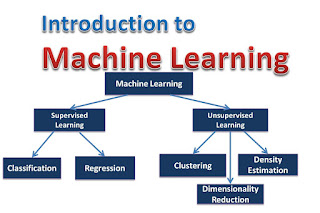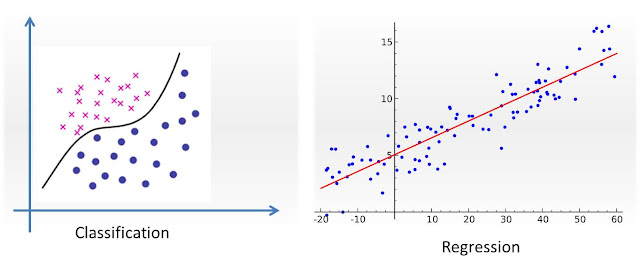What really is machine learning? Let’s try to explain it in a way that everyone can easily understand and appreciate. Here we would define Machine Learning and outline the various aspects of machine learning.
The following are covered:
- What is Machine Learning
- The Theory of Machine Learning
- An Example of Classification
- Types of Machine Learning Problems
- Final Notes
- Further Reading
1. What is Machine Learning?
Machine Learning is an branch of artificial intelligence that provides the computer system the ability to progressively learn and improve its performance on handling various tasks without being explicitly programmed to perform all the task.
Another definition of Machine Learning explains it as ‘the process of trying to deduce unknown values from known values’.
 |
| Figure 1: Types of Machine Learning Problem |
2. The Theory of Machine Learning
Remember the second definition of machine learning has to do with trying to determine unknown values given a set of know values.
Example: if a set of 30 students class 5 normally scores between 70% and 100% in a test and a set of 30 students in class 3 normally scores between 40% and 60%.
Now if you have a score of 45% from a new student, different from the ones you know and you have to place this student in a class, what class would you place him? Obviously, since he scored 45% which lies between 40% and 60%, you will likely place him in class 3. This is an example of classification. Now let’s take a more formal definition.
3. An Example of Classification
Given a set of data(training data set) that comprise of N observations {xn}, where n = 1,…,N, and you are also given the corresponding values {tn} (target value), the goal of machine learning is to predict the value of t for a new value of x.
The approach would be to first construct an appropriate function y(x). The values of this function for the new input x constitute the predictions for the corresponding value of t.
There would be need to examine also examine the probability that the predicted value of t is correct. This probability is expressed as p(t |x), that is probability of t given x. This expresses how certain or uncertain our prediction is. By now you understand the theory behind machine learning: that is making predictions about what is not known.
Understanding this theoretical approach would help us understand the various types of Machine Learning problems.
4. Types of Machine Learning Problem
From Figure 1, we could see the classes of machine learning problem. Machine learning problems are divided into two broad categories: Supervised Learning and Unsupervised Learning.
4a. Supervised Learning
In supervised learning applications, the training data set(given data set) comprises of samples of input vectors {x} along with their corresponding target vectors. The task here would be to find a function f(x) that takes a data point x and produces the equivalent target value t such that f(x) = t
Supervised Learning problems can either be Classification or Regression.
Classification: In classification, the training data is from some finite set. Here the aim is to assign each of the input vectors to one of a definite number of discrete categories.
Regression: Here, the training data set is in R-dimensional real space. Here the output would just be one or more continuous variables
4b. Unsupervised Learning
Unsupervised Learning has to do with finding patterns or trend within the input data. Unsupervised learning could either be clustering, density estimation or dimensionality reduction.
In clustering, we find clusters or groups of similar examples withing the data.
Density estimation has to do with finding groups of data that belong to the same density distribution
Dimensionality Reduction reduces data from a higher dimensional space to lower dimension like 2 or 3 dimensions.
There is also another class of machine learning problems known as semi-supervised learning. It would just suffice to know that under this class we have:
- Reinforcement learning
- Active learning
5. Final Notes
I do think that this lesson would not be too difficult for you to follow. For now we have an overview of the whole concept of Machine Learning. In subsequent lessons, we would go a little deeper into formal definitions using the statistical derivations.
Feel free to read check out more Machine Learning Videos and Tutorial and do leave a comment to let me know if you have any challenges.
6. Further Reading
Read more on neural network from the following beginner tutorials:
Basics of Neural Networks
Basics of Perceptron in Neural Networks
Basics of Back-propagation in Neural Networks
Multilayer Perceptions (MLP) Explained

[…] will try to explain Likelihood Function in very clear and simple terms. Likelihood Function in Machine Learning and Data Science is the joint probability distribution(jpd) of the dataset given as a function of […]
Your blog is very unique and interesting about Machine Learning Training.
very nice and informative blog Machine Learning Training.
Thanks for the super Content and More Machine Learning Training Data Science Training Provides to me
Thanks for your detailed explanation. Sir continued extensions on linear regression using statsmodel and another video on sns plots can’t be found.
Thanks a lot Dr. Krishna!
Great Post, Really very happy to say,your post is very interesting to read.keep sharing.
Highly informative article. This site has lots of information and it is useful for us. Thanks for sharing your views.
Thanks for sharing nice information and nice article and very useful information…
Glad you like Machine Learning tutorial and it proves useful to you. We tried to explain each and every term related to Machine Learning Training
One of the best taught courses.The content is extremely interesting and useful.
Informative post. Concept has been explained very well.Looking forward for such informative posts
Really useful information. I learned some new points here.I wish you luck as you continue to follow that passion.
Nice!
Excellent post. Gained a lot of knowledge from it. Looking ahead for more of such interesting postings
thanks for sharing such valuable information with us. it’s hard to come by well-informed people in this particular topic, but you explained this really good..
Nice Blog. Thanks for the information. about the What is machine learning and when it used concepts.
I really enjoy studying on this website, it holds wonderful posts. Excellent Machine Learning blog you have got here… It’s difficult to find excellent writing like yours these days. I really appreciate individuals like you!
[…] 3. Reinforcement Learning: This is a more recent class of Machine Learning problem developed in 1998 and is concerned with finding the best action to take in a given situation to maximize the expected outcome. One application area is reinforcement learning is in Game Playing where the objective at each point is to take an action that increases the changes of wining. […]
Hi, Thanks for sharing nice articles…
This is an excellent course which helped me a lot .Thanks for sharing the content
Excellent post. Gained a lot of knowledge from it. Looking ahead for more of such interesting postings
Thanks for sharing the valuable information .this article makes it easier to understand the topics very clear. It helped me a lot
Glad it helped you!
Thanks for such a great work
Thanks for such a great work
Thank you for giving this excellent blog. Useful to the beginner’s
You seem to be very well-versed at talking about your ideas and opinions in a way that’s easy for other people to understand.
A very interesting article. It was nice to read this and I especially liked the author’s perspective. I think a lot of people who read this will really enjoy and appreciate what’s been written here.
Great job, i love this topic & especially the way you have explained it is really awsome. Thnaks for sharing this info..
thank you for shearing nice information
nice explanation and thank you for shearing
Thanks For Sharing Yor Information,Your Content Is Very HealpFull
thanks nice
Great Information about . Thanks for sharing